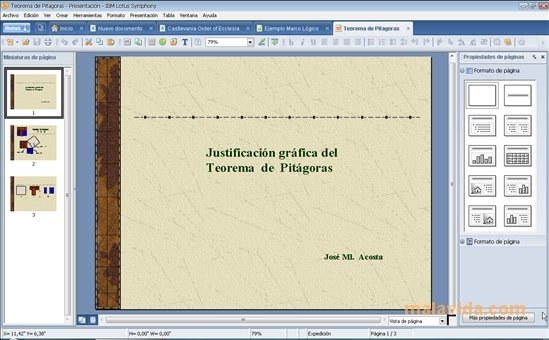Lotus Symphony free download - Lotus Sametime, Lotus SmartSuite, X1 Professional Client, and many more programs. An advanced software suite Free Updated Download now. 12 Haz 2021 — Details: lotus notes client 8.5 free download. Details: Ibm lotus notes free download - Lotus Symphony, Mac Notepad, NoteList. Download Notes Client Basic 8.5.3 2. Install on MAC OS X 10.9.4 3.
| Original author(s) | Keith Blount |
|---|---|
| Developer(s) | Literature & Latte |
| Initial release | 20 January 2007 |
| Stable release | macOS 3.2.2 / 15 December 2020; 9 months ago[1] iOS 1.2.1 / 14 December 2019; 21 months ago[2] Windows 3.0.1 / 25 March 2021; 6 months ago[3] |
| Preview release | |
| Operating system |
|
| Type | |
| License | Proprietary (shareware) |
| Website | literatureandlatte.com/scrivener |

The IBM Lotus Symphony suite includes all the basic tools that you could expect in such an application: spell checker and tables for documents, pre-designed templates for presentations and charts for spreadsheets - to name a few - besides the usual configuration options as regards fonts, colors and the like.
Scrivener (/ˈskrɪvənər/) is a word-processing program and outliner designed for authors.[5] Scrivener provides a management system for documents, notes and metadata. This allows the user to organize notes, concepts, research, and whole documents for easy access and reference (documents including rich text, images, PDF, audio, video, web pages, etc.). Scrivener offers templates for screenplays, fiction, and non-fictionmanuscripts. After writing a text, the user may export it for final formatting to a standard word processor, screenwriting software, desktop publishing software, or TeX.
Features[edit]

Features include a corkboard, the ability to rearrange files by dragging-and-dropping virtual index cards on the corkboard, an outliner, a split screen mode that enables users to edit several documents at once, a full-screen mode, the ability to export text into multiple document formats (including popular e-book formats like EPUB and Mobipocket for Kindle, and markup languages such as Fountain, HTML, and MultiMarkdown), the ability to assign multiple keywords (and other metadata) to parts of a text and to sort the parts by keyword (such as characters, locations, themes, narrative lines, etc.), hyperlinks between parts of a text, and 'snapshots' (the ability to save a copy of a particular document prior to any drastic changes).
Scrivener allows photos, URLs, and multiple other file formats, to be dragged into its interface as well. Because of its breadth of interfaces and features, it has positioned itself not only as a word processor, but as a project management tool for writers, and includes many user-interface features that resemble Xcode, Apple's integrated development environment (IDE). One computer programmer has called Scrivener 'an IDE for writing'.[6]
Platforms[edit]
Lotus Symphony Mac Download Torrent
Keith Blount created, and continues to maintain, the program as a tool to help him write the 'big novel', allowing him to keep track of ideas and research.[7][8] It is built mostly on libraries and features of Mac OS X from version 10.4 onward. In 2011, a Windows version of the software was released, written and maintained by Lee Powell.[9]

iOS[edit]
Scrivener for iOS was launched July 20, 2016. Current version is 1.2.1 and requires iOS 9+.[10]
Linux[edit]
There is no official release for Linux, but there is a public beta version[4] which has been abandoned[11] but still is available to use.[12]
Macintosh[edit]
The latest version of Scrivener for Mac is version 3.2.2, and requires macOS Sierra or newer.[1] Scrivener can be obtained from the Mac App Store, but since the Mac App Store application is only usable on OS X 10.6.6 and later, users of earlier versions of OS X must buy it directly from the developer's website instead of the Mac App Store.[13]
The company also makes Scrivener 2.5 available for earlier version of Mac OS X, but claims it is the final version of the software that was built to run on both PowerPC and Intel systems running Mac OS X 10.4 through 10.8. This version is available on the direct sale page in the sidebar titled 'Mac OS X 10.4–8 and PowerPC'.[13]
In addition to the Scrivener version 2 releases, the direct download page provides access to the obsolete version 1.54, but licenses are no longer available for purchase. The 1.54 release is compatible with Mac OS X versions 10.4 through 10.6.[13]
Ibm Lotus Symphony
Windows[edit]
The latest stable version of Scrivener for Windows is 3.0.1.[3] This upgrade '[r]equires Windows 7 SP1+with .NET Framework 4.6.2+, and a minimum display resolution of 1024x768px'[14] according to Literature & Latte's website. Those who bought Scrivener 1 on or later than 20th November 2017 qualify for a free upgrade. Those who bought Scrivener 1 before that date qualify for a 49% discount.[15]
See also[edit]
References[edit]
- ^ ab'Scrivener Release Notes'. Literature & Latte. Retrieved 31 August 2020.
- ^'Scrivener Release Notes'. Literature & Latte. Retrieved 31 August 2020.
- ^ ab'Scrivener Release Notes'. literatureandlatte.com. Retrieved 31 August 2020.
- ^ ab'Scrivener 1.9.0.1 Linux beta released 21 October 2015'. literatureandlatte.com. Retrieved 4 January 2016.
- ^Heffernan, Virginia (6 January 2008). 'An interface of one's own'. The New York Times. Archived from the original on 10 December 2008. Retrieved 2 October 2015.
- ^Bailey, Dan (24 January 2013). 'Writing as programming'. danbailey.net. Archived from the original on 2 October 2015. Retrieved 2 October 2015.
- ^Watt, Justin (2012). 'Keith Blount, founder and lead developer at Literature & Latte'. objectivesee.com. Archived from the original on 2 February 2012. Retrieved 2 October 2015.
- ^Cordella, Francesco (May 2013). 'Scrivener and me: an interview with Keith Blount'. avventuretestuali.com. Archived from the original on 27 April 2014. Retrieved 8 January 2016.
- ^'About - Clever Dictionary'. cleverdictionary.com. Archived from the original on 26 November 2014. Retrieved 2 October 2015.
- ^'Scrivener just got a whole lot smaller'. Literature and Latte (official Scrivener site). 27 June 2016. Retrieved 29 June 2016.
- ^Laden, Greg (29 August 2014). 'Scrivener on Linux: Try it, you'll like it'. scienceblogs.com. Archived from the original on 8 September 2014. Retrieved 8 January 2017. Updated as: Laden, Greg (2 January 2016). 'Scrivener on Linux: Oh Well...'scienceblogs.com. Archived from the original on 14 May 2016. Retrieved 8 January 2017.
- ^Orosz, Attila (18 March 2018). 'The Return of Scrivener'. The Way of Linux. Archived from the original on 11 November 2020.
- ^ abc'Scrivener for Mac OS X Download'. Literature & Latte. Retrieved 2 October 2015.
- ^'Scrivener | Literature & Latte'. Literature & Latte.
- ^'Upgrade to Scrivener 3 for Windows'. Literature & Latte.
External links[edit]
Lotus Symphony
- Official website
- 'Developer Spotlight: Literature and Latte'. Applegeeks. February 2007. Archived from the original on 11 January 2008. Retrieved 2 October 2015.
- Hernandez, Gwen (2012). Scrivener for dummies. Chichester, UK; Hoboken, NJ: John Wiley & Sons. ISBN9781118312476. OCLC773671868.
- Turnball, Giles (February 2007). 'Keith Blount's Scrivener'. MacUser. Archived from the original on 24 May 2007. Retrieved 2 October 2007.
After around eight months in beta, Lotus Symphony 3.0 has finally made it to a final release. This free alternative to Microsoft Office is based on the open-source OpenOffice, but throws in some useful features of its own to make it stand out from the crowd. These include support for VBA scripts to tempt professional users to switch to Symphony (and then pay for the cloud-based LotusLive collaboration services), plus plug-ins that enable you to extend Symphony’s usability in the directions you wish it to go.
Symphony offers three tools: a word-processor, spreadsheet and presentations tool, all of which are accessible through a single program window – documents appear as tabs, enabling you to switch between them quickly and easily. Symphony also features a built-in web browser, which gives you easy access to plug-ins and other useful functions.
The three major tools do everything expected of them – although files are saved in the OpenDocument format, all three programs can also work with native Office formats (including the latest formats found in Office 2007 and 2010). The ribbon interface found in Office is replaced by a vertical sidebar on the right of the screen. This is divided into sections, giving you access to all the various tools found in each program.
A lot has changed since version 1.3 was released – a full list of new features can be found at the Symphony website - but there’s not a lot that could be described as revolutionary, particularly to those brought up on a diet of Office or OpenOffice. However, these new features are essential in order to ensure Lotus Symphony has a fighting chance of attracting people to switch from competing products, and with more plug-ins on the way, it seems its expandability and versatility could prove to be a big attraction going forward.
Verdict:
A vast improvement on the previous release, Lotus Symphony is rapidly closing the gap between it and its immediate competition.